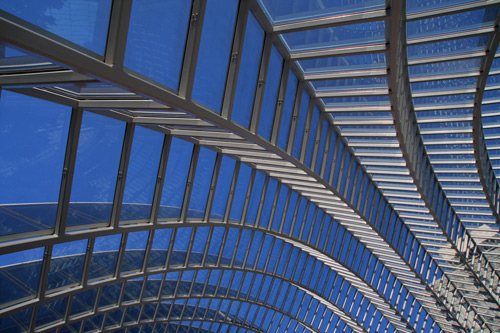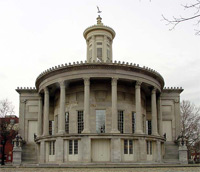
by Nathaniel Popkin
April 10, 2008
The architect Winka Dubbeldam (by way of The
Illadelph by way
of Men's Health) says that her firm Archi-techtonics, isn't "into stylistic things, but deriving form from performance." This manifesto is a sign that in
architecture
Modernism -- form follows function, remember -- remains gravity. Performance, after all, is function riding high after drinking a triple shot soy latte with
cinnamon on
top.
But there are important, and instructive, differences. A building that functions is passive; one that performs aids and enhances. It gives back. In order to
make form follow
function but also to account for different functions, Modernism separates uses. A building that performs is capable of balancing even contradictory functions with
a smile and a
wink. Thus, stylistically, function informs a restrained aesthetic, performance something visually more active and perhaps interactive.
So Dubbeldam and other ambitious contemporary architects face an enormous challenge: balancing sometimes conflicting desires, needs, and functions in a way that
makes everyone --
from the building tenant to the Pacific Islander whose way of life is being destroyed by rising sea levels caused by global warming -- more productive and
invigorated. What a
performance!
You know what follows. Once buildings start performing, we're going to have to ask our cities to do so too. A city that functions provides shelter,
transportation, common
ground for the production of culture and commerce. A city that performs also wows us, inspires, entertains, dazzles, and raises the specter of our consciousness.
It is
comforting and challenging, open and particular, it makes human life not just possible but extraordinary. And it does so with less, therefore achieving the
greatest feat of all:
the production of a habitat that enables contemporary humans to enhance rather than destroy the planet.
We aren't performing well, are we? (Well, no, given how much trash was hauled away on Saturday, it seems we're barely functioning; given the spectrum of social
and economic
failure, we aren't providing even the basics.)
Former Septa GM Faye Moore once said the transit agency's job was to move people from point A to point B. Period. Maybe she was clever enough to lower our
expectations, but I
see her comment as precisely why Philadelphia underperforms even when it (in)adequately functions. The best Septa stations are clean and well-lit; the best
transit stations
worldwide are fun and energizing -- and a lot busier than ours are.
The same goes for public spaces and parks, where as I noted a year ago, mere function leaves us
bored; it's simply
no longer enough. Having recently had a peek-in at the rather spectacular glass-covered gardens inside the Bellagio in Las Vegas, I'll say in this regard and
while thinking
precisely about the Kimmel Center's rooftop garden (that painfully wasted opportunity), when it comes to performance, we might learn a little from Las Vegas.
Doing so doesn't mean embracing a simplistic approach to city planning. Nor do I advocate abandoning our city's straightforward, hardworking way. Quite the
opposite, for a city
that performs enjoys a far greater return on its assets than a city that merely functions. Turn the Benjamin Franklin Parkway into a grand pedestrian entrance to
Fairmount Park
(with thousands of bikes available to take you into the park, a Ferris wheel, and lots of places to sit and play) and you'll quickly forget how fast you used to
motor down the
center lane between the Art Museum and City Hall. In a city like ours there's little return on functional efficiency, but a great deal to profit from the engaged
pedestrian.
Ed. note: Steve Weinik wrote a fantastic what-if essay about this just last week. The Parkway would still move traffic on its outer lanes, but the center lanes
would be turned
over to a pedestrian mall. Read it HERE.
The same efficiency impulse that resulted in the Parkway has us frequently tearing down old, historic, and suggestive buildings simply because they are in
the way. There
is play and contrast in the urban landscape that performs; there is morbid regularity in the cityscape that merely functions. This, particularly, is an old
notion, but we give
it contemporary relevance out of necessity. If we continue to under-perform, devaluing our assets, we'll be too poor to even function.
 I leave off with another missed opportunity to profit from the golden egg of our inheritance. It is minor in the scheme of things, but instructive. At Second and
Walnut stands
William Strickland's Merchant Exchange building, the curving marble temple of early American commerce. (Consider it the American Commerce Center of its day.) Is
there a more
handsome building in Philadelphia? Are there better stairs on which to sit and read a book, more docile lions, a more suggestive portico? Yet all you and I can
do there is sit
on those lions and dream.
I leave off with another missed opportunity to profit from the golden egg of our inheritance. It is minor in the scheme of things, but instructive. At Second and
Walnut stands
William Strickland's Merchant Exchange building, the curving marble temple of early American commerce. (Consider it the American Commerce Center of its day.) Is
there a more
handsome building in Philadelphia? Are there better stairs on which to sit and read a book, more docile lions, a more suggestive portico? Yet all you and I can
do there is sit
on those lions and dream.
This great icon and its river stone plaza, which served as the mercantile and transport center of the ambitious 19th century city, is closed to us. It functions,
sure, as office
space for the National Park Service. But it ought to perform. Give the place to a witty and anachronistic theatre group; to a restaurateur to engage the public
space; to a
group of peddlers and food vendors, musicians, and jugglers. Least of all, light it at night, so that it lives on in our imagination. Right now, it's all but
dead to us, and
we, in turn, are left a little less alive.
–Nathaniel Popkin
nathaniel.popkin@gmail.com
For Nathaniel Popkin archives, please see HERE, or visit his web site HERE.
For The Possible City, please see HERE.
|